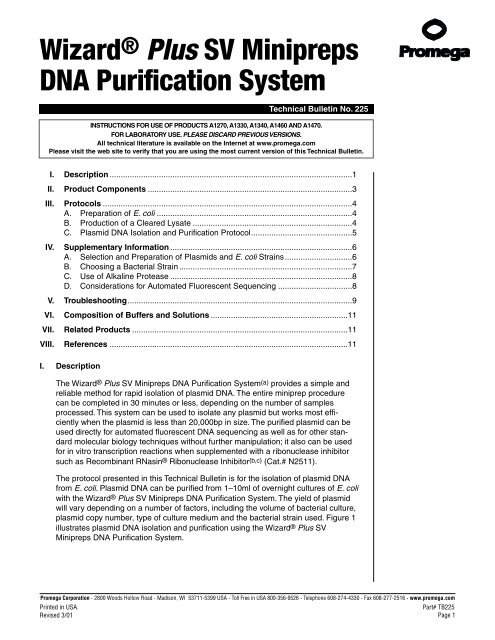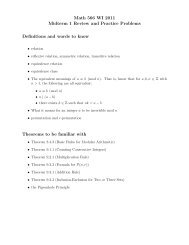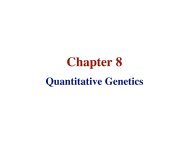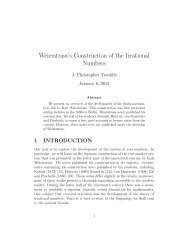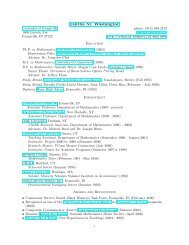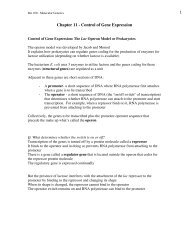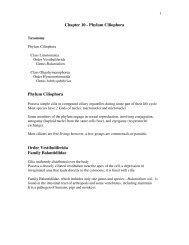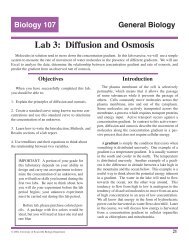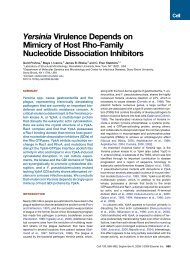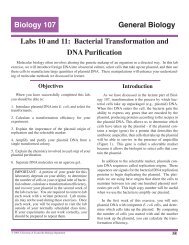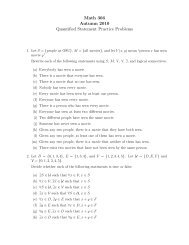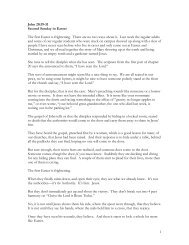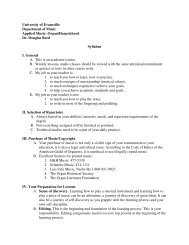Wizard® Plus SV Minipreps DNA Purification System Technical ...
Wizard® Plus SV Minipreps DNA Purification System Technical ...
Wizard® Plus SV Minipreps DNA Purification System Technical ...
- No tags were found...
You also want an ePaper? Increase the reach of your titles
YUMPU automatically turns print PDFs into web optimized ePapers that Google loves.
II.Product ComponentsProduct Size Cat.#Wizard® <strong>Plus</strong> <strong>SV</strong> <strong>Minipreps</strong> <strong>DNA</strong> <strong>Purification</strong> <strong>System</strong>(with Vacuum Adapters) 50 preps A1340Each system contains sufficient reagents for 50 isolations from 1–10ml of culture. Includes:• 20ml Wizard® <strong>Plus</strong> <strong>SV</strong> Cell Resuspension Solution• 20ml Wizard® <strong>Plus</strong> <strong>SV</strong> Cell Lysis Solution• 30ml Wizard® <strong>Plus</strong> <strong>SV</strong> Neutralization Solution• 20ml Wizard® <strong>Plus</strong> <strong>SV</strong> Column Wash Solution• 50 Wizard ® <strong>Plus</strong> <strong>SV</strong> <strong>Minipreps</strong> Spin Columns• 50 Collection Tubes (2ml)• 550µl Alkaline Protease Solution• 13ml Nuclease-Free Water• 20 Miniprep Vacuum Adapters(d)• 1 ProtocolDo Notexchange or replace componentsof the Wizard ®<strong>Plus</strong> <strong>SV</strong> <strong>Minipreps</strong> <strong>DNA</strong><strong>Purification</strong> <strong>System</strong> withcomponents from any otherWizard® <strong>Plus</strong> <strong>System</strong> (e) .Components from theWizard ® <strong>Plus</strong> and Wizard®<strong>Plus</strong> <strong>SV</strong> <strong>System</strong>s are notinterchangeable.Product Size Cat.#Wizard® <strong>Plus</strong> <strong>SV</strong> <strong>Minipreps</strong> <strong>DNA</strong> <strong>Purification</strong> <strong>System</strong>(with Vacuum Adapters) 250 preps A1470Each system contains sufficient reagents for 250 isolations from 1–10ml of culture. Includes:• 75ml Wizard ® <strong>Plus</strong> <strong>SV</strong> Cell Resuspension Solution• 75ml Wizard® <strong>Plus</strong> <strong>SV</strong> Cell Lysis Solution• 100ml Wizard® <strong>Plus</strong> <strong>SV</strong> Neutralization Solution• 100ml Wizard ® <strong>Plus</strong> <strong>SV</strong> Column Wash Solution• 250 Wizard® <strong>Plus</strong> <strong>SV</strong> <strong>Minipreps</strong> Spin Columns• 250 Collection Tubes (2ml)• 2,700µl Alkaline Protease Solution• 25ml Nuclease-Free Water• 20 Miniprep Vacuum Adapters• 1 ProtocolProduct Size Cat.#Wizard ® <strong>Plus</strong> <strong>SV</strong> <strong>Minipreps</strong> <strong>DNA</strong> <strong>Purification</strong> <strong>System</strong> 50 preps A1330250 preps A1460Product Size Cat.#Wizard® <strong>Plus</strong> <strong>SV</strong> <strong>Minipreps</strong> <strong>DNA</strong> <strong>Purification</strong> <strong>System</strong>, Trial Size 10 preps A1270Each system contains sufficient reagents for 10 isolations from 1–10ml of culture. Includes:Note: Products A1330and A1460 do not includevacuum adapters.• 3ml Wizard ® <strong>Plus</strong> <strong>SV</strong> Cell Resuspension Solution• 3ml Wizard® <strong>Plus</strong> <strong>SV</strong> Cell Lysis Solution• 4ml Wizard® <strong>Plus</strong> <strong>SV</strong> Neutralization Solution• 4ml Wizard® <strong>Plus</strong> <strong>SV</strong> Column Wash Solution• 10 Wizard® <strong>Plus</strong> <strong>SV</strong> <strong>Minipreps</strong> Spin Columns• 10 Collection Tubes (2ml)• 550µl Alkaline Protease Solution• 1ml Nuclease-Free Water• 5 Miniprep Vacuum Adapters• 1 ProtocolStorage and Stability: All Wizard® <strong>Plus</strong> <strong>SV</strong> <strong>Minipreps</strong> components should bestored at 22–25°C. Reagent expiration dates are listed on the product label.Promega Corporation · 2800 Woods Hollow Road · Madison, WI 53711-5399 USA · Toll Free in USA 800-356-9526 · Telephone 608-274-4330 · Fax 608-277-2516 · www.promega.comPrinted in USA.Part# TB225Revised 3/01 Page 3
III.ProtocolsMaterials to Be Supplied by the User(Solution compositions are provided in Section VI.)• LB agar plates containing antibiotic• LB medium containing antibiotic• ethanol (95%)• microcentrifuge capable of 14,000 × g• sterile 1.5ml microcentrifuge tubes• centrifuge capable of 10,000 × gPrior to using a new Wizard ® <strong>Plus</strong> <strong>SV</strong> <strong>Minipreps</strong> <strong>DNA</strong> <strong>Purification</strong> <strong>System</strong>,dilute the provided Wizard® <strong>Plus</strong> <strong>SV</strong> Column Wash Solution as follows:Add 7ml of 95% ethanol for a final volume of 11ml for the 10-prep system(Cat.# A1270).Add 35ml of 95% ethanol for a final volume of 55ml for the 50-prep system(Cat.# A1330 and A1340).Add 170ml of 95% ethanol for a final volume of 270ml for the 250-prep system(Cat.# A1460 and A1470).Note: An A 600 reading of2–4 ensures that cells havereached the proper growthdensity for harvesting andplasmid <strong>DNA</strong> isolation.A. Preparation of E. coli1. Use a single, well-isolated colony from a fresh Luria-Bertani (LB) agar plate(containing antibiotic) to inoculate 1–10ml of LB medium (containing the sameantibiotic). We recommend LB culture medium. Rich media, such as TerrificBroth, may produce very high cell densities that may overload the <strong>DNA</strong>purification system.2. Incubate overnight (12–16 hours) at 37°C in a shaking incubator. Incubationtime can be optimized to increase the plasmid <strong>DNA</strong> yield for a given culturevolume. However, it has been observed that as a culture ages the <strong>DNA</strong> yieldmay begin to decrease due to cell death and lysis within the culture.For high-copy-number plasmids, we do not recommend processing more than5ml of bacterial culture. If more than 5ml of culture is processed, the capacity of theWizard® <strong>Plus</strong> <strong>SV</strong> <strong>Minipreps</strong> Spin Column will be exceeded and no increase in plasmidyield will be obtained.For low-copy-number plasmids, it may be necessary to process larger volumesof bacterial culture (up to 10ml) for recovery of sufficient <strong>DNA</strong>. Processing greaterthan 10ml of culture will lead to insufficient clearing of the bacterial lysate andthus increased contaminants in the plasmid <strong>DNA</strong>.To prevent shearingof chromosomal <strong>DNA</strong>,Do Not vortex after Step2. Mix only by inverting thetubes.B. Production of a Cleared Lysate1. Harvest 1–5ml (high-copy-number plasmid) or 10ml (low-copy-number plasmid)of bacterial culture by centrifugation for 5 minutes at 10,000 x g in a tabletopcentrifuge. Pour off the supernatant and blot the inverted tube on a papertowel to remove excess media.2. Add 250µl of Cell Resuspension Solution and completely resuspend the cellpellet by vortexing or pipetting. It is essential to thoroughly resuspend thecells. If not already in a microcentrifuge tube, transfer the resuspended cells tosterile 1.5ml microcentrifuge tube(s).3. Add 250µl of Cell Lysis Solution and mix by inverting the tube 4 times (do notvortex). Incubate until the cell suspension clears, approximately 1–5 minutes.Note: It is important to observe partial clearing of the lysate before proceedingto addition of the Alkaline Protease Solution (Step 4); however, do notincubate longer than 5 minutes.Promega Corporation · 2800 Woods Hollow Road · Madison, WI 53711-5399 USA · Toll Free in USA 800-356-9526 · Telephone 608-274-4330 · Fax 608-277-2516 · www.promega.comPart# TB225Page 4Printed in USA.Revised 3/01
4. Add 10µl of Alkaline Protease Solution and mix by inverting the tube 4 times.Incubate for 5 minutes at room temperature.Alkaline protease inactivates endonucleases and other proteins released duringthe lysis of the bacterial cells that can adversely affect the quality of the isolated<strong>DNA</strong>.5. Add 350µl of Wizard® <strong>Plus</strong> <strong>SV</strong> Neutralization Solution and immediately mix byinverting the tube 4 times (do not vortex).6. Centrifuge the bacterial lysate at maximum speed (around14,000 x g) in amicrocentrifuge for 10 minutes at room temperature.C. Plasmid <strong>DNA</strong> Isolation and <strong>Purification</strong> ProtocolDo Notincubate for more than 5minutes with AlkalineProtease Solution at Step4, as nicking of the plasmid<strong>DNA</strong> may occur.The Wizard ® <strong>Plus</strong> <strong>SV</strong> <strong>Minipreps</strong> <strong>DNA</strong> <strong>Purification</strong> <strong>System</strong> allows a choice of methodsfor purification of plasmid <strong>DNA</strong> when systems with Miniprep Vacuum Adapters arepurchased (Cat.# A1340, A1470). Plasmid <strong>DNA</strong> may be purified from the bacteriallysate using microcentrifugation to force the cleared lysate through the Wizard®<strong>Plus</strong> <strong>SV</strong> <strong>Minipreps</strong> Spin Column and to wash the plasmid <strong>DNA</strong>. Alternatively, avacuum can be used to pull the lysate through the Spin Column and to wash theplasmid <strong>DNA</strong>. Miniprep Vacuum Adapters allow the use of a vacuum manifold (e.g., aVac-Man® Laboratory Manifold) and vacuum source for <strong>DNA</strong> purification.Centrifugation ProtocolPrepare plasmid <strong>DNA</strong> purification unitsby inserting one Spin Column into one2ml Collection Tube for each sample.1. Transfer the cleared lysate (approximately850µl, Section III.B, Step 6) tothe prepared Spin Column by decanting.Avoid disturbing or transferring anyof the white precipitate with the supernatant.2. Centrifuge the supernatant at maximumspeed in a microcentrifuge for 1 minuteat room temperature. Remove the SpinColumn from the tube and discard theflowthrough from the Collection Tube.Reinsert the Spin Column into theCollection Tube.3. Add 750µl of Column Wash Solution,previously diluted with 95% ethanol, tothe Spin Column.4. Centrifuge at maximum speed in amicro-centrifuge for 1 minute at roomtemperature. Remove the Spin Columnfrom the tube and discard theflowthrough. Reinsert the Spin Columninto the Collection Tube.Vacuum ProtocolAttach one Miniprep Vacuum Adapterwith Luer-Lok ® fitting to one port of themanifold (e.g., Promega’s Vac-Man® orVac-Man® Jr. Laboratory VacuumManifold). Insert a Spin Column intothe Miniprep Vacuum Adapter untilsnugly in place.1. Transfer the cleared lysate (approximately850µl, Section III.B, Step 6) tothe prepared Spin Column by decanting.Avoid disturbing or transferring anyof the white precipitate with the supernatant.2. Apply a vacuum of at least 15 inches ofmercury (Hg) to pull the liquid throughthe Spin Column. When all liquid hasbeen pulled through the column,release the vacuum.3. Add 750µl of the Column WashSolution, previously diluted with 95%ethanol, to the Spin Column.4. Apply a vacuum to pull the ColumnWash Solution through the SpinColumn. When all the liquid has beenpulled through the Spin Column,release the vacuum.Note: If the white precipitateis accidentally transferredto the Spin Column,pour the Spin Columncontents back into a sterile1.5ml microcentrifugetube and centrifuge foranother 5–10 minutes atmaximum speed. Transferthe resulting supernatantinto the same SpinColumn that was used initiallyfor this sample. TheSpin Column can bereused but only for thissample.Comparison of Inches ofHg to Other PressureMeasurements.15 Inches Hg50.8kPa381 Torr0.501atm7.37psi38.1cm Hg508mbarPromega Corporation · 2800 Woods Hollow Road · Madison, WI 53711-5399 USA · Toll Free in USA 800-356-9526 · Telephone 608-274-4330 · Fax 608-277-2516 · www.promega.comPrinted in USA.Part# TB225Revised 3/01 Page 5
Centrifugation Protocol (continued)5. Repeat the wash procedure using250µl of Column Wash Solution.6. Centrifuge at maximum speed in amicrocentrifuge for 2 minutes at roomtemperature.7. Transfer the Spin Column to a new,sterile 1.5ml microcentrifuge tube beingcareful not to transfer any of theColumn Wash Solution with the SpinColumn. If the Spin Column hasColumn Wash Solution associated withit, centrifuge again for 1 minute at maximumspeed.Vacuum Protocol (continued)5. Repeat the wash procedure, using250µl of Column Wash Solution. Applya vacuum to pull the liquid through theSpin Column.6. Dry the Spin Column by applying avacuum for 10 minutes.7. Turn off the vacuum and transfer theSpin Column to a 2ml Collection Tube.Centrifuge at maximum speed for 2minutes to remove any residualColumn Wash Solution. Discard the2ml Collection Tube and any liquid collectedduring this step.Note: At Step 11, if <strong>DNA</strong>will be used for automatedfluorescent sequencing,do not add TE buffer to<strong>DNA</strong>.8. Transfer the Spin Column to a new, sterile 1.5ml microcentrifuge tube.9. Elute the plasmid <strong>DNA</strong> by adding 100µl of Nuclease-Free Water to the Spin Column.Centrifuge at maximum speed for 1 minute at room temperature in a microcentrifuge.10. After eluting the <strong>DNA</strong>, remove the assembly from the 1.5ml microcentrifuge tube anddiscard the Spin Column.11. <strong>DNA</strong> is stable in water without addition of a buffer if stored at –20°C or below. <strong>DNA</strong> isstable at 4°C in TE buffer. To store the <strong>DNA</strong> in TE buffer, add 10µl of 10X TE buffer tothe 100µl of eluted <strong>DNA</strong>.12. Cap the microcentrifuge tube and store the purified plasmid <strong>DNA</strong> at –20°C or below.IV.Supplementary InformationA. Selection and Preparation of Plasmids and E. coli StrainsPlasmid <strong>DNA</strong> can be purified from overnight cultures of E. coli with the Wizard®<strong>Plus</strong> <strong>SV</strong> <strong>Minipreps</strong> <strong>DNA</strong> <strong>Purification</strong> <strong>System</strong>. The yield of plasmid will varydepending on a number of factors, including the plasmid copy number, cell densityof bacterial culture, type of culture medium and the bacterial strain used.Plasmid copy number is an important factor affecting plasmid <strong>DNA</strong> yield. Copynumber is determined primarily by the region of <strong>DNA</strong> surrounding and includingthe origin of replication. This region, known as the replicon, controls replicationof plasmid <strong>DNA</strong> by bacterial enzyme complexes. Some <strong>DNA</strong> sequences, wheninserted into a particular plasmid, can lower the copy number of the plasmid byinterfering with replication.Choose a single, well-isolated colony from a fresh Luria-Bertani (LB) agar plate(containing antibiotic) and use the colony to inoculate 1–10ml of LB media (alsocontaining antibiotic). The inoculated medium should be incubated overnight(12–16 hours) at 37°C. An A 600 of 2.0–4.0 for high-copy-number plasmidsensures that bacteria have reached the proper growth density for harvesting andplasmid <strong>DNA</strong> isolation.Promega Corporation · 2800 Woods Hollow Road · Madison, WI 53711-5399 USA · Toll Free in USA 800-356-9526 · Telephone 608-274-4330 · Fax 608-277-2516 · www.promega.comPart# TB225Page 6Printed in USA.Revised 3/01
B. Choosing a Bacterial StrainEndonuclease I is a 12kDa periplasmic protein that degrades double-stranded<strong>DNA</strong>. This protein is encoded by the gene endA. The E. coli genotype endA1refers to a mutation in the wildtype endA gene, which produces an inactive formof the nuclease. E. coli strains with this mutation are referred to as EndA – .Table 1 contains a list of EndA– and EndA + E. coli strains.Table 1. EndA– and EndA+ Strains of E. coli.EndA – EndA +BJ5183 BL21(DE3)DH1 CJ236DH20 HB101DH21 JM83DH5α JM101JM103 JM110JM105 LE392JM106 MC1061JM107 NM522 (all NM series strains are EndA + )JM108 NM554JM109 P2392MM294 PR700 (all PR series strains are EndA+)SK1590 Q358SK1592 RR1SK2267 TB1SRB TG1XL1-Blue Y1088 (all Y10 series strains are EndA+)XLO BMH71–18ES1301The absence of endA1 (or endA) in an E. coli genotype denotes the presence ofthe wildtype gene, which expresses an active endonuclease I. The wildtype isindicated as EndA + . Using the Wizard ® <strong>Plus</strong> <strong>SV</strong> <strong>Minipreps</strong> <strong>DNA</strong> <strong>Purification</strong><strong>System</strong>, high-quality <strong>DNA</strong> is easily obtained from both EndA+ and EndA – strains.However, some EndA+ strains can be problematic for a number of applications.In general, we recommend the use of EndA – strains whenever possible, particularlyfor applications such as automated fluorescent sequencing.For applications such as fluorescent <strong>DNA</strong> sequencing, special considerationsshould be given to the selection of plasmid and E. coli strains to optimize yieldand plasmid quality. Optimal automated fluorescent sequencing results areobtained by using high-copy-number plasmids and EndA– strains of E. coli forplasmid propagation.Promega Corporation · 2800 Woods Hollow Road · Madison, WI 53711-5399 USA · Toll Free in USA 800-356-9526 · Telephone 608-274-4330 · Fax 608-277-2516 · www.promega.comPrinted in USA.Part# TB225Revised 3/01 Page 7
C. Use of Alkaline ProteaseTo improve the quality of plasmid <strong>DNA</strong> isolated from both EndA+ and EndA–strains of E. coli, Promega’s Wizard ® <strong>Plus</strong> <strong>SV</strong> <strong>Minipreps</strong> <strong>DNA</strong> <strong>Purification</strong><strong>System</strong> includes an alkaline protease solution. Alkaline protease, originally identifiedas subtilisin Carlsberg, is isolated from the bacterium Bacillus licheniformis(1). Approximately 250µg are added per sample at the end of the lysis step,during the preparation of a cleared bacterial lysate to inactivate endonucleases.The alkaline protease also acts to nonspecifically degrade proteins, thus reducingthe overall level of protein contaminants in the cleared bacterial lysate (2,3).Alkaline protease is useful in this procedure because it is optimally active at apH of 9 and above, the conditions present during alkaline lysis procedure. Whenthe lysate is neutralized, alkaline protease activity is substantially reduced (4,5).The <strong>DNA</strong> prepared by this procedure has been tested extensively in a range ofmolecular biology applications including fluorescent sequencing, restrictionenzyme digestion and in cloning.D. Considerations for Automated Fluorescent SequencingNote: Optimal automatedfluorescent sequencingresults are routinelyobtained by using highcopy-numberplasmidsand EndA– strains ofE. coli.For the application of automated fluorescent sequencing, special considerationshould be given to the selection of plasmid type and E. coli strain to optimize yieldand plasmid quality.Purified plasmid <strong>DNA</strong> must be within the proper concentration range for successfulautomated cycle sequencing (ideally 0.2µg/µl and not less than 0.1µg/µl).When working with plasmid <strong>DNA</strong> from low-copy-number plasmids, we stronglyrecommend that <strong>DNA</strong> concentrations be determined by agarose gel/ethidiumbromide quantitation prior to any application (6). <strong>DNA</strong> quantitation by spectrophotometricmethods is prone to errors and requires a large amount of sample.The Wizard ® <strong>Plus</strong> <strong>SV</strong> <strong>Minipreps</strong> <strong>System</strong> routinely yields 3.5–5.0µg of plasmid<strong>DNA</strong> when using a pGEM® Vector (f) and DH5α cells in 1.5ml of LB medium.For low-copy-number plasmids, a larger culture volume is required to obtain sufficient<strong>DNA</strong> for sequencing. Typical low-copy-number plasmid yields are1.5–3.0µg of plasmid <strong>DNA</strong> from 10ml of LB culture medium, using thepALTER®-1 Vector(f,g) (ampicillin-resistant) and DH5α cells.Special Considerations for Sequencing Using BigDye ChemistryThe Wizard ® <strong>Plus</strong> <strong>SV</strong> <strong>Minipreps</strong> <strong>System</strong> yields template suitable for use in anumber of fluorescent dye sequencing methods, including ABI PRISM®BigDye terminator (The Perkin-Elmer Corporation Cat.# 4303149, 4303150,4303151) reactions.When performing dilutions of the BigDye terminator-ready reaction mix, it isessential to dilute the reaction mix using the appropriate dilution buffer (250mMTris-HCl [pH 9.0], 10mM MgCl 2 ).When using high-copy-plasmids, over 500 bases of readable sequence can beobtained from terminator-ready reaction mixes diluted as much as six-fold.Promega Corporation · 2800 Woods Hollow Road · Madison, WI 53711-5399 USA · Toll Free in USA 800-356-9526 · Telephone 608-274-4330 · Fax 608-277-2516 · www.promega.comPart# TB225Page 8Printed in USA.Revised 3/01
Table 2 outlines the amount of terminator-ready reaction mix and dilution bufferrequired to obtain the appropriate dilution for BigDye terminator reactions. Fordetails on running these reactions, please refer to the protocol supplied with theBigDye terminator system. For each reaction, add the reagents in Table 2 to aseparate tube.Table 2. Appropriate Dilutions for BigDye Terminator Reactions.AmountComponent No Dilution 1:2 1:4 1:6terminator-readyreaction mix* 8.0µl 4.0µl 2.0µl 1.3µldouble-stranded plasmid<strong>DNA</strong> template 200–500ng 200–500ng 200–500ng 200–500ngprimer 3.2pmol 3.2pmol 3.2pmol 3.2pmoldilution buffer** 0µl 2.0µl 3.0µl 3.4µlNuclease-Free Waterto a final volume of 20µl 20µl 20µl 20µl* Terminatr-ready reaction mix is a 2.5X solution.** Dilution buffer is a 5X solution.V. TroubleshootingSymptoms Possible Causes CommentsPoor cell lysis Too many bacterial cells Use cultures grown to an A 600 ofin culture medium 2–4. All media should contain anantibiotic. Use only recommendedculture volumes for low-and highcopy-numberplasmids (10ml maximumfor low copy and 5ml for highcopy-numberplasmids).Poor resuspension of Thoroughly resuspend cell pelletsbacterial cell pellet prior to cell lysis. Vortex or pipetpellet with Cell ResuspensionSolution. No cell clumps should bevisible after resuspension.No plasmid <strong>DNA</strong> purified Ethanol was not added to Prepare the Column Wash SolutionColumn Wash Solution as instructed in Section IIIbefore beginning the procedure.Inaccurate quantitation of Quantitate plasmid <strong>DNA</strong> yield viaplasmid <strong>DNA</strong> yield agarose gel/ethidium bromideelectrophoresis.<strong>DNA</strong> floats out of well Be certain to allow the full tenduring loading of gel for minutes for drying (with vacuumquantitationprotocol) after the final wash stepto allow evaporation of anyremaining ethanol.Increase loading dye concentration.Low-copy-number Use high-copy-number plasmids.plasmid usedFor questions notaddressed here, pleasecontact your localPromega Branch Officeor distributor. Contactinformation available at:www.promega.com.E-mail:techserv@promega.comPromega Corporation · 2800 Woods Hollow Road · Madison, WI 53711-5399 USA · Toll Free in USA 800-356-9526 · Telephone 608-274-4330 · Fax 608-277-2516 · www.promega.comPrinted in USA.Part# TB225Revised 3/01 Page 9
Promega Corporation · 2800 Woods Hollow Road · Madison, WI 53711-5399 USA · Toll Free in USA 800-356-9526 · Telephone 608-274-4330 · Fax 608-277-2516 · www.promega.comPart# TB225Page 10V. Troubleshooting (continued)Symptoms Possible Causes CommentsLow plasmid <strong>DNA</strong> yields Overgrowth of bacterial Make certain that antibiotics areculture by nontrans- used in all media, both liquid andformed cellssolid.Bacterial culture too old Inoculate antibiotic-containingmedia with freshly isolated bacterialcolony from an overnight plate.Incubate at 37°C for 12–16 hours.Low-copy-number Know the copy number of plasmidplasmid usedused; we recommend use of highcopy-numberplasmids.Plasmid <strong>DNA</strong> yield was Use agarose gel/ethidium bromidenot accuratelyquantitation; do not rely on thequantitatedaccuracy of spectrophotometricquantitation.Nicking of plasmid <strong>DNA</strong> Overincubation during Incubation of cell suspensionthe alkaline lysis step with the Lysis Solution andAlkaline Protease should each notexceed 5 minutes.Poor results with Too little <strong>DNA</strong> was added Inoculate fresh LB medium withautomated fluores- to the sequencing a newly isolated E. coli colony.cent sequencing reaction Purify plasmid <strong>DNA</strong> and quantitatewith agarose gel/ethidiumbromide electrophoresis.TE buffer was used for Repurify plasmid <strong>DNA</strong> and elute in<strong>DNA</strong> elutionNuclease-Free Water.Plasmid concentration Ethidium bromide gel electrophornotaccuratelyesis must be used to accuratelyquantitatedquantitate plasmid <strong>DNA</strong>.No restriction digestion Concentration of restric- Increase the amount of restrictiontion enzyme, length of enzyme or the length of incubationdigestion need to be time. Digest at suggested temperincreasedature and in the optimal buffer forthe restriction enzyme used.Perform an ethanol precipitation ofthe plasmid <strong>DNA</strong> to remove anysalts that may have carried over.Genomic <strong>DNA</strong> Vortexing or overmixing Do not vortex samples after addicontaminationresulted in genomic tion of Lysis Solution to prevent<strong>DNA</strong> contaminationWrong reagents usedshearing of genomic <strong>DNA</strong>.Make certain that Column WashSolution is diluted with ethanolbefore use. Note: Wizard® <strong>Plus</strong>and Wizard® <strong>Plus</strong> <strong>SV</strong> componentsare not interchangeable.<strong>DNA</strong> yields on gel Traces of contaminants Phenol:chloroform extract andlook low compared to may be present in the ethanol precipitate <strong>DNA</strong>, then washspectrophotometric eluted <strong>DNA</strong>, which inflate with 70% ethanol before repeatingreadings the spectrophotometer spectrophotometric readings.readingsQuantitate <strong>DNA</strong> by agarosegel/ethidium bromide electrophoresisfor the most accuratequantitation results.Printed in USA.Revised 3/01
VI.Composition of Buffers and Solutions10X TE bufferLB medium100mM Tris-HCl (pH 7.5)10mM EDTA10g5g5g15gcasein peptoneyeast extractNaClagar (for plates only)Dissolve in 1L of distilled water.Autoclave and cool to 55°C beforeadding antibiotic (see Table 1).For further information regarding Wizard ® buffer compositions, please contact Promega<strong>Technical</strong> Services at (608) 274-4330 or Toll Free at (800) 356-9526.VII. Related ProductsWizard® <strong>SV</strong> 96 Plasmid <strong>DNA</strong> <strong>Purification</strong> <strong>System</strong>sProduct Size Cat.#Wizard® <strong>SV</strong> 96 Plasmid <strong>DNA</strong> <strong>Purification</strong> <strong>System</strong>(a) 1 × 96 preps A22505 × 96 preps A2255Wizard ® <strong>SV</strong> 96 Cell Resuspension Solution 500ml A7113Wizard® <strong>SV</strong> 96 Cell Lysis Solution 500ml A7123Wizard ® <strong>SV</strong> 96 Neutralization Solution 500ml A1481Wizard ® <strong>SV</strong> 96 Wash Solution 185ml A1311Wizard® <strong>SV</strong> 96 <strong>DNA</strong> Binding Plates 10 pack A2271Wizard ® <strong>SV</strong> 96 Lysate Clearing Plates 10 pack A2241Vac-Man ® Laboratory Vacuum Manifold 20-sample capacity A7231Vac-Man® Laboratory Vacuum Manifold 2-sample capacity A7660Vac-Man ® 96 Vacuum Manifold 96 well capacity A2291Vacuum Miniprep Adapters 20 each A1331<strong>SV</strong> Total RNA Isolation <strong>System</strong>(d) 50 preps Z3100<strong>SV</strong> Total RNA Isolation <strong>System</strong>, Trial Size 10 preps Z3101VIII.References1. Guntelberg, A.V. and Otteson, M. (1954) Compt. Rend. Trav. Lab. Carlsberg 29, 36.2. Aehle, W. et al. (1993) Rational protein engineering and industrial application:structure prediction by homology and rational design of protein-variants withimproved ‘washing performance’—the alkaline protease from Bacillusalcalophilus. J. Biotechnol. 28, 31.3. van der Osten, C. et al. (1993) Protein engineering of subtilisins to improve stabilityin detergent formulations. J. Biotechnol. 28, 55.4. Vetter, R. et al. (1994) Highly alkaline proteases. U.S. Pat. No. 5,352,603.(October 4, 1994).5. Shetty, J.K., Patel, C.P. and Nicholson, M.A. (1995) Method of preparation of purifiedalkaline protease. U.S. Pat. No. 5,439,817. (August 8, 1995).6. Kahn, M. et al. (1979) Plasmid cloning vehicles derived from plasmids ColE1, F,R6K, and RK2. Meth. Enzymol. 68, 268.Promega Corporation · 2800 Woods Hollow Road · Madison, WI 53711-5399 USA · Toll Free in USA 800-356-9526 · Telephone 608-274-4330 · Fax 608-277-2516 · www.promega.comPrinted in USA.Part# TB225Revised 3/01 Page 11
(a) U.S. Pat. No. 5,981,235 has been issued to Promega Corporation for methods for isolating nucleic acids using alkaline protease.(b) U.S. Pat. No. 5,552,302, European Pat. No. 0 422 217 and Australian Pat. No. 646803 have been issued to Promega Corporation for themethods and compositions for production of human recombinant placental ribonuclease inhibitor.(c) U.S. Pat. Nos. 4,966,964, 5,019,556 and 5,266,687, which claim vectors encoding a portion of human placental ribonuclease inhibitor, areexclusively licensed to Promega Corporation.(d) Patent Pending.(e) U.S. Pat. Nos. 5,658,548 and 5,808,041 and Australian Pat. No. 689815 have been issued to Promega Corporation for nucleic acid purificationon silica gel and glass mixtures.(f) U.S. Pat. No. 4,766,072 has been issued to Promega Corporation for transcription vectors having two different bacteriophage RNA polymerasepromoter sequences separated by a series of unique restriction sites into which foreign <strong>DNA</strong> can be inserted.(g) U.S. Pat. No. 5,955,363 has been issued to Promega Corporation for a vector for in vitro mutagenesis and use thereof.© 1996–2001 Promega Corporation. All Rights Reserved.pALTER, pGEM, RNasin, Vac-Man and Wizard are trademarks of Promega Corporation and are registered with the U.S. Patent and TrademarkOffice.ABI PRISM is a registered trademark of, and BigDye is a trademark of, The Perkin-Elmer Corporation. DH5α is a trademark of LifeTechnologies, Inc. Luer-Lok is a registered trademark of Becton, Dickinson and Company.All prices and specifications are subject to change without prior notice.Product claims are subject to change. Please contact Promega <strong>Technical</strong> Services or access thePromega online catalog for the most up-to-date information on Promega products.Promega Corporation2800 Woods Hollow RoadMadison, WI 53711-5399 USATelephone 608-274-4330Fax 608-277-2516Internetwww.promega.comPromega Corporation · 2800 Woods Hollow Road · Madison, WI 53711-5399 USA · Toll Free in USA 800-356-9526 · Telephone 608-274-4330 · Fax 608-277-2516 · www.promega.comPart# TB225Page 12Printed in USA.Revised 3/01


